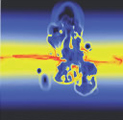

![]()
The Lab’s Public Affairs Office is hosting free Science at the Theater events later this month and in early May. “Just Say No to Carbon Emissions,” on Monday, April 26, will feature a panel discussion of cheap solar energy, carbon sequestration, and energy efficiency in China. “The House of the Future” is the topic for Monday, May 10, where panelists will provide a sneak preview of tomorrow’s zero-energy home, including cool roofs, smart windows, and computer-driven control systems. Both events start at 7 p.m. at the Berkeley Rep Theater (2025 Addison St.)
 A team of researchers with Berkeley Lab and UC Berkeley has developed a new way to process white organic light-emitting diodes (OLEDs) for solid-state lighting. Replacing conventional lighting in buildings with white OLEDs could significantly reduce electricity use. Buildings account for more than 40 percent of carbon emissions in the United States. The research team included Biwu Ma (pictured) of the Molecular Foundry, plus Haifeng Gao, Daniel Poulsen and Jean Fréchet of the Materials Sciences Division. More>
A team of researchers with Berkeley Lab and UC Berkeley has developed a new way to process white organic light-emitting diodes (OLEDs) for solid-state lighting. Replacing conventional lighting in buildings with white OLEDs could significantly reduce electricity use. Buildings account for more than 40 percent of carbon emissions in the United States. The research team included Biwu Ma (pictured) of the Molecular Foundry, plus Haifeng Gao, Daniel Poulsen and Jean Fréchet of the Materials Sciences Division. More>
 Research: NERSC Helps Solve the Mysteries of Star-Forming Galaxies
Research: NERSC Helps Solve the Mysteries of Star-Forming Galaxies Astronomers have in recent years been surprised to find hulking brutes among the baby galaxies of the early universe. Studded with bright, giant clumps of rapidly forming stars, these big galaxies hail from a time when the cosmos was less than 4 billion years old, yet each contains about the mass of a modern Milky Way, which took 10 billion years to form. Once considered oddities, these galaxies are now thought to be the engines that drove the Universe's most active period of star formation. It remains a mystery, however, how such massive galaxies came to be so quickly and what has happened to them in our modern universe. More>
 Using the National Energy Research Scientific Computing Center's Parallel Distributed Systems Facility and the Brookhaven National Laboratory’s Relativistic Heavy Ion Collider, physicists have detected and confirmed the first-ever antimatter hypernucleus, called "antihypertriton." Translated, the newly detected "antihypertriton" means a nucleus of antihydrogen containing one antiproton and one antineutron — plus one heavy relative of the antineutron, an antilambda hyperon. More>
Using the National Energy Research Scientific Computing Center's Parallel Distributed Systems Facility and the Brookhaven National Laboratory’s Relativistic Heavy Ion Collider, physicists have detected and confirmed the first-ever antimatter hypernucleus, called "antihypertriton." Translated, the newly detected "antihypertriton" means a nucleus of antihydrogen containing one antiproton and one antineutron — plus one heavy relative of the antineutron, an antilambda hyperon. More>
 World of Science: Bridging Gaps in Climate Studies
World of Science: Bridging Gaps in Climate Studies The data available on climate is like Swiss cheese — wherever you look, there are holes. Historic measurements may not exist, while others can be difficult to obtain at the desired number of sites. Enter Cari Kaufman, a UC Berkeley professor of statistics. She helps researchers use the information they have to estimate what's missing — and design better experiments going forward. More>
Work to install new parking near the Guest House will require the closure of one lane on Lawrence Road. The closure will be required through the end of May. Parking along this area will also be blocked off. Traffic will be controlled by flaggers. Vehicles and pedestrians in the area should use caution and follow posted signage. For more information, contact Tim Kemper (x6917).
Today at Berkeley Lab encourages comments, suggestions, and story ideas. Please send them here.
TABL is produced by Public Affairs' Communications Group